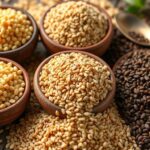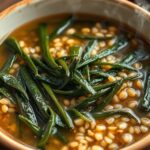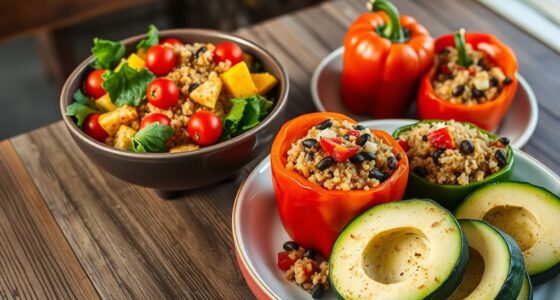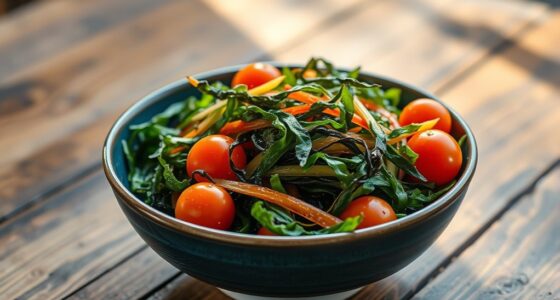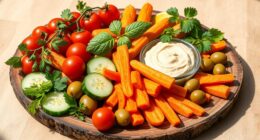Vegetarian meals with ancient grains like quinoa, farro, amaranth, and millet are a great way to add flavor, texture, and nutrition to your diet. These grains work well in salads, bowls, soups, and baked goods, offering plant-based protein and earthy, nutty flavors that elevate your dishes. They’re easy to prepare and environmentally friendly, making your meals not only delicious but sustainable too. Keep exploring to discover tasty recipes and creative ideas with these versatile grains.
Key Takeaways
- Incorporate ancient grains like quinoa, farro, amaranth, and millet into salads, bowls, soups, and baked dishes for variety.
- Use these grains as hearty bases or sides to complement vegetables, legumes, and flavorful herbs.
- Leverage their plant-based protein, especially quinoa as a complete protein, to enhance nutritional value.
- Prepare grains quickly with minimal effort, ideal for quick, nutritious vegetarian meals.
- Choose whole grains to support sustainable eating and reduce environmental impact while enjoying delicious meals.
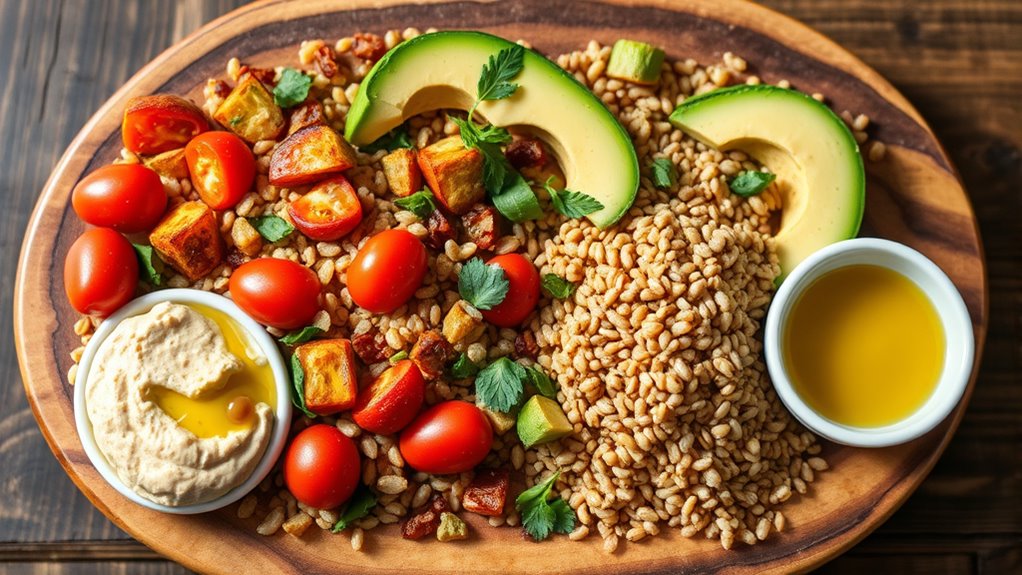
Ancient grains are making a comeback in vegetarian cooking, offering both flavor and nutritional benefits. These grains, such as quinoa, farro, amaranth, and millet, bring a new dimension of taste and texture to your meals while also boosting your diet’s healthfulness. One of their key advantages is grain versatility—you can incorporate them into salads, bowls, soups, and even baked goods, making them adaptable to almost any dish. Whether you’re craving a hearty breakfast or a satisfying dinner, ancient grains can be the star ingredient that elevates your meal. Their ability to absorb flavors and blend seamlessly with vegetables, herbs, and spices makes them a go-to choice for creating diverse vegetarian dishes.
Beyond their culinary flexibility, ancient grains shine as a valuable source of plant-based protein. As a vegetarian, you know the importance of including enough protein in your diet, and these grains help fill that need naturally. For example, quinoa stands out because it’s a complete protein, meaning it contains all nine essential amino acids your body can’t produce on its own. Farro and millet also pack a decent amount of protein, making them perfect for satisfying, nutrient-dense meals. Incorporating these grains ensures you’re not just eating for flavor but also fueling your body with essential nutrients. They help you build muscle, stay full longer, and maintain energy levels throughout the day.
When preparing meals with ancient grains, their ease of cooking adds to their appeal. Many, like quinoa and millet, cook quickly and require minimal prep, so you can whip up nutritious vegetarian dishes on busy weeknights. Their ability to serve as a base or a side dish makes them versatile enough to pair with a wide variety of vegetables, legumes, and flavorful sauces. Plus, their earthy, nutty flavors add depth and complexity to any dish, making even simple ingredients feel special. Whether you’re making a grain salad packed with roasted vegetables or a warm grain bowl topped with beans and fresh herbs, ancient grains are your reliable, nutritious foundation.
Using whole grains also supports sustainable eating habits, as they typically require less processing and have a lower environmental impact. Embracing these grains in your vegetarian cooking not only enhances your meals but also benefits the planet.
In essence, embracing ancient grains in your vegetarian cooking provides the perfect combination of flavor, texture, and nutrition. Their grain versatility allows you to experiment and create a broad spectrum of meals, all while ensuring you get enough plant-based protein to support your health. Incorporating these grains into your diet not only meets your nutritional needs but also adds variety and excitement to your culinary repertoire. Once you start exploring their potential, you’ll find yourself reaching for these wholesome, ancient ingredients more often—and reaping the benefits in every bite.
Frequently Asked Questions
Can Ancient Grains Be Integrated Into Gluten-Free Vegetarian Recipes?
Yes, you can definitely incorporate ancient grains into gluten-free vegetarian recipes. For gluten-free baking, grains like millet or buckwheat work well. You can also create vegan grain bowls using quinoa, amaranth, or teff to add texture and nutrition. These grains boost flavor and nutrients, making your dishes more satisfying. Simply experiment with different combinations to find what suits your taste, and enjoy delicious, wholesome meals.
What Are the Best Ancient Grains for Beginners in Vegetarian Cooking?
Imagine a palette of vibrant colors and textures—quinoa, millet, and buckwheat—standing out as your beginner-friendly options. These grains showcase incredible versatility, fitting into salads, bowls, or porridges with ease. They’re simple to prepare, require minimal fuss, and absorb flavors beautifully. Choosing these grains allows you to explore vegetarian cooking confidently, building your skills while enjoying nutritious, delicious meals that highlight the natural beauty of ancient grains.
How Do Ancient Grains Compare Nutritionally to Modern Grains?
You’ll find that ancient grains often have more fiber, protein, and micronutrients than modern grains, offering better grain health benefits. Nutritional differences include higher antioxidants and lower glycemic index, which can help regulate blood sugar. These grains also tend to be less processed, preserving their natural nutrients. Incorporating ancient grains into your meals boosts overall nutrition, making your vegetarian dishes both wholesome and satisfying.
Are There Any Common Allergens Associated With Ancient Grains?
You might worry about ancient grain allergies, but they’re generally safe for most people. However, some individuals experience allergen cross-reactivity, especially with grains like quinoa or amaranth. While rare, ancient grains can trigger allergic reactions similar to modern grains. If you have known grain allergies, it’s wise to consult your doctor before trying new ancient grains, just to avoid any unexpected allergic responses.
How Should I Store and Preserve Ancient Grains for Long-Term Use?
To store and preserve ancient grains long-term, you should keep grain storage in airtight containers in a cool, dark, and dry place. Use preservation techniques like vacuum sealing or refrigeration for extra freshness. Avoid moisture and direct sunlight, which can cause spoilage. Regularly check for any signs of pests or mold, and consider freezing grains if you want to extend their shelf life even further.
Conclusion
By incorporating ancient grains into your vegetarian meals, you’re transforming ordinary dishes into epic feasts that could rival royal banquets. Imagine every bite bursting with the power of history and the vitality of nature, fueling your body like a unstoppable force. These grains don’t just nourish—they elevate your entire dining experience to legendary status. So, plunge in and release the ancient wisdom in every forkful—your taste buds and health will thank you for it!
Ilana has been a vegan for over 10 years. She originally made the switch for health reasons, but soon found herself becoming more and more passionate about the ethical and environmental implications of a vegan lifestyle. Ilana is the author of The Graceful Kitchen, a blog all about veganism. She loves to cook up delicious and nutritious vegan meals, and share her recipes with others who are interested in leading a cruelty-free life. Ilana is also a strong advocate for using whole foods as the foundation of a healthy diet, and believes that going vegan is one of the best ways to achieve this.







